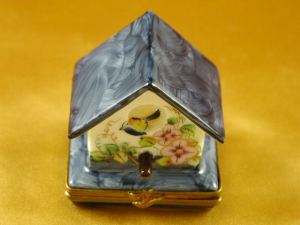Whether you are passionate about collecting antique items or love adorning your home, the Limoges porcelain boxes can be valuable additions to your home vintage collections. While the beauty of these boxes with their impressive designs and exquisite artistry is something to treasure, they can also give you handsome returns at auction later on.
Whatever be your purpose of collecting these pieces of art, maintaining, and taking proper care of them is essential to keep their true worth intact. Peek at some of the things that you can do for maintaining your Limoges boxes.
Opening the Limoges Box
The very first thing that you need to pay attention to is to ensure that you do not end up damaging the hinges of the box while opening it. These are delicate items and should be handled with extreme care. When opening the box keep the metal clasp in the front and place your thumbnails in between the metal rims, pulling them gently in opposite directions.
Remember, the metal clasp is for the purpose of decoration and therefore pulling it may cause it to tamper. You should never use any sharp object like knife while trying to open the box, nor try to pull the porcelain. Just as you had been gentle in opening the box be considerable in closing it too.
General Care and Maintenance
Like any objects of décor at your home, your Limoges porcelain products also require little bit of regular maintenance which can be as trivial as mere dusting. However, since the objects are ethereal, you have to use a soft cloth to ensure that the painting is not maimed or scratched in the process. For occasions, you can simply wipe off the additional dust with a soft cloth.
Removing Stains
Upset about those stains, which marred the beauty of your glistening white Limoges box? Do not worry, for there is a remedy for this too. For this, all you need to do is fill up a dishpan or a sink with sufficient padding on sides with warm water and 2 tablespoons of mild detergent or dishwashing liquid along with a one-fourth cup of cleaning powder.
The latter should be free from ammonia, chlorine, bleach and solvents as these ingredients are harsh and a strict no-no on such delicate porcelain figurines and boxes. Let your porcelain boxes to soak for about 20 to 30 minutes when you can see the stains disappearing. If the stains are deep-rooted and have gone inside crevices, you can go for a repetition of the process. Once the stains disappear, simply wash the items with warm water, and pat dry with a soft towel.
One final tip, it is always worthwhile to test whether your Limoges boxes are not getting tampered further and is compatible with the solution. Test it out with a soaked cotton ball on a smaller area.
Whatever be your purpose of collecting these pieces of art, maintaining, and taking proper care of them is essential to keep their true worth intact. Peek at some of the things that you can do for maintaining your Limoges boxes.
Opening the Limoges Box
The very first thing that you need to pay attention to is to ensure that you do not end up damaging the hinges of the box while opening it. These are delicate items and should be handled with extreme care. When opening the box keep the metal clasp in the front and place your thumbnails in between the metal rims, pulling them gently in opposite directions.
Remember, the metal clasp is for the purpose of decoration and therefore pulling it may cause it to tamper. You should never use any sharp object like knife while trying to open the box, nor try to pull the porcelain. Just as you had been gentle in opening the box be considerable in closing it too.
General Care and Maintenance
Like any objects of décor at your home, your Limoges porcelain products also require little bit of regular maintenance which can be as trivial as mere dusting. However, since the objects are ethereal, you have to use a soft cloth to ensure that the painting is not maimed or scratched in the process. For occasions, you can simply wipe off the additional dust with a soft cloth.
Removing Stains
Upset about those stains, which marred the beauty of your glistening white Limoges box? Do not worry, for there is a remedy for this too. For this, all you need to do is fill up a dishpan or a sink with sufficient padding on sides with warm water and 2 tablespoons of mild detergent or dishwashing liquid along with a one-fourth cup of cleaning powder.
The latter should be free from ammonia, chlorine, bleach and solvents as these ingredients are harsh and a strict no-no on such delicate porcelain figurines and boxes. Let your porcelain boxes to soak for about 20 to 30 minutes when you can see the stains disappearing. If the stains are deep-rooted and have gone inside crevices, you can go for a repetition of the process. Once the stains disappear, simply wash the items with warm water, and pat dry with a soft towel.
One final tip, it is always worthwhile to test whether your Limoges boxes are not getting tampered further and is compatible with the solution. Test it out with a soaked cotton ball on a smaller area.





